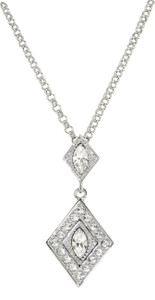
Diamond shaped pendant
Log in for pricing
This is our trade site for museums, gift shops and visitor attractions. Looking to buy for yourself? Visit our retail site - TimeLine Gifts
Queen Victoria’s Diamond Crown Collection
On the death of her beloved husband, Prince Albert, in 1861, the grief-stricken Queen Victoria retreated into full mourning and, for a time with-drew from public life. In 1870, soon after she resumed some of her public duties, she commis-sioned this tiny diamond crown from Garrard & Co to wear on top of her widow's veil. The silver frame is set with 1,187 diamonds, which unlike coloured stones - were allowed during mourning. Being of small stature, she found the Imperial State Crown too heavy, and out of proportion to her size. She broke diamonds out of a necklace to create this small head ornament, which measures 9cm across, 10cm high and weighs just 6 ounces.Queen Victoria first wore her small diamond crown at the State Opening of Parliament on 9th February 1871 with the Imperial State Crown being carried on a cushion before her. It was an event she recorded in her diary; 'Wore a dress trimmed with ermine and my new small diamond crown over a veil, on my head'. The small crown, which Victoria wore frequently for the rest of her reign, came to symbolise her. Queen Victoria left the small diamond crown to the Crown; it was occasionally worn by Queen Alexandra and Queen Mary.
Victoria was born at Kensington Palace on 24th May 1819. Her father died shortly after her birth and she became heir to the throne as the three uncles who were ahead of her in succession had no legitimate children who survived. On the death of William in 1837, she became Queen at the age of 18.
She married in Prince Albert in 1840. He is best remembered for the Great Exhibition of 1851, the profits from which helped to establish the South Kensington museums complex in London. Victoria was deeply attached to her husband and she sank into depression after he died, aged 42, in 1861. She had lost a devoted husband and her principal trusted adviser in affairs of state. For the rest of her reign she wore black. Until the late 1860s she rarely appeared in public but was per-suaded to open Parliament in person in 1866 and 1867.
Victoria and her family travelled and were seen on an unprecedented scale, thanks to transport improvements - she was the first reigning monarch to use trains - she made her first train journey in 1842. Despite her advanced age, Victoria continued her duties to the end and on her death in 1901 it was placed on her coffin at Osborn House before it was conveyed to London for the State Funeral.